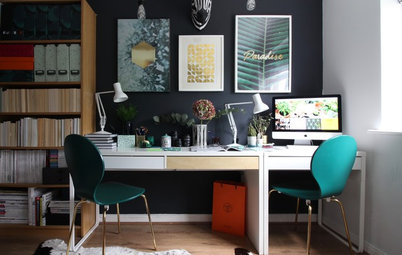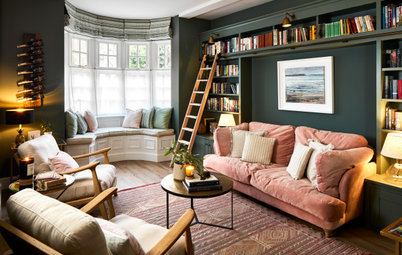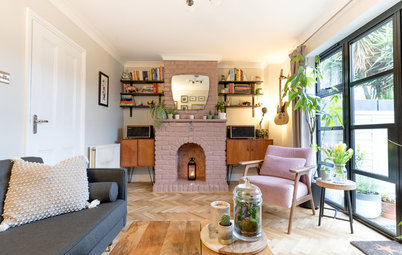How to Hit the Ground Running After a Setback
Discover how six pros are putting their companies on a firm footing during the pandemic to build future resilience
After a major crisis like the Covid pandemic, it pays to adapt in order to get off on the right foot and keep growing your business. Here, professionals on Houzz talk about how they’ve been rebuilding demand, planning their finances and boosting staff morale.
Contributing professionals: Nimi Attanayake of nimtim Architects; Yoko Kloeden of Yoko Kloeden Design; Laura Simpson and Diana Greenhalgh, co-founders of My Bespoke Room; Fiona Duke of Fiona Duke Interiors; Emilie Mauran of EMR Architecture
Contributing professionals: Nimi Attanayake of nimtim Architects; Yoko Kloeden of Yoko Kloeden Design; Laura Simpson and Diana Greenhalgh, co-founders of My Bespoke Room; Fiona Duke of Fiona Duke Interiors; Emilie Mauran of EMR Architecture
“We produce long articles on our blog then put out snippets on our social media channels,” Yoko Kloeden says. “We started our newsletters during [the first] lockdown and this has been a success. It’s a big time commitment to produce good content consistently, but it’s been worth it. We sent newsletters to our old leads who’d contacted us in the past year (and made it clear that we don’t spam and they can always opt out). One of them came back and it turned into a project.”
My Bespoke Room is also sending regular newsletters with interiors inspiration. “Our homes have all had to ‘step up’ in this pandemic, so we’re writing great content to help our community and customers,” Laura Simpson says. Diana Greenhalgh adds, “We’re also using this period to make sure our Houzz portfolio is up to date, so our profile is looking strong.”
“We’re only a small studio, but staying visible feels key,” Fiona Duke says. “We’ve made a conscious effort to maintain an element of regular marketing and provide content on social media.”
My Bespoke Room is also sending regular newsletters with interiors inspiration. “Our homes have all had to ‘step up’ in this pandemic, so we’re writing great content to help our community and customers,” Laura Simpson says. Diana Greenhalgh adds, “We’re also using this period to make sure our Houzz portfolio is up to date, so our profile is looking strong.”
“We’re only a small studio, but staying visible feels key,” Fiona Duke says. “We’ve made a conscious effort to maintain an element of regular marketing and provide content on social media.”
Rebuild demand
As well as writing social media and blog posts, our pros suggest actively letting potential clients know you’re operating.
“We’ve followed up on Houzz messages and with potential clients who made contact pre-Covid,” Emilie Mauran says. “We’re also following the market in our working area, so when a potential client calls, we already know the house they’re talking about.”
“We’re signalling on our website, Houzz and social media accounts that we’re working remotely but still serving clients,” Diana says. “We’re also reaching out to customers for reviews to be able to share with readers and followers.”
As well as writing social media and blog posts, our pros suggest actively letting potential clients know you’re operating.
“We’ve followed up on Houzz messages and with potential clients who made contact pre-Covid,” Emilie Mauran says. “We’re also following the market in our working area, so when a potential client calls, we already know the house they’re talking about.”
“We’re signalling on our website, Houzz and social media accounts that we’re working remotely but still serving clients,” Diana says. “We’re also reaching out to customers for reviews to be able to share with readers and followers.”
Boost staff morale
As the backbone of a company, it’s crucial to keep staff motivated and feeling involved, especially as many might be working from home, at least part of the time, for the foreseeable future.
“It’s been a tough time for our staff, with a lot of them living on their own or in flatshares away from their families,” Nimi says. “We’ve had to be a lot more aware and sensitive to their mental wellbeing.
“We’ve tried to create a more structured way of working and check in with them as much as possible,” she says, “from having daily briefing sessions, design reviews and catch-ups, to virtual Friday afternoon drinks after work.”
Laura and Diana also stay in frequent contact with staff. “We’re making sure our team feel safe and supported, and are comfortable working from home.” Laura says. “We’re engaging with all our designers to give them additional training and tips,” Diana adds.
As the backbone of a company, it’s crucial to keep staff motivated and feeling involved, especially as many might be working from home, at least part of the time, for the foreseeable future.
“It’s been a tough time for our staff, with a lot of them living on their own or in flatshares away from their families,” Nimi says. “We’ve had to be a lot more aware and sensitive to their mental wellbeing.
“We’ve tried to create a more structured way of working and check in with them as much as possible,” she says, “from having daily briefing sessions, design reviews and catch-ups, to virtual Friday afternoon drinks after work.”
Laura and Diana also stay in frequent contact with staff. “We’re making sure our team feel safe and supported, and are comfortable working from home.” Laura says. “We’re engaging with all our designers to give them additional training and tips,” Diana adds.
Plan your finances
Assessing outgoings and streamlining finances is key to surviving the months ahead.
“We’re keeping an eye on cash flow,” Nimi says. “The challenge has been to manage the uncertainty. Many of our paused projects re-started once the restrictions were eased [in the summer], but there’s still a lot of uncertainty.
“[To help us] find the right balance between securing future income for the practice while not over-stretching our outgoings, we’re considering more freelance input to meet the potential future demand,” she says.
“I do a 12 months cashflow projection and update it every month,” Yoko says, “so I keep a close eye on whether the projects are being completed as planned. It helps me to plan when I need to hire new staff and at what experience level.”
It can also help to reach out to your landlord. “We’ve renegotiated our office rent,” Emilie says.
Assessing outgoings and streamlining finances is key to surviving the months ahead.
“We’re keeping an eye on cash flow,” Nimi says. “The challenge has been to manage the uncertainty. Many of our paused projects re-started once the restrictions were eased [in the summer], but there’s still a lot of uncertainty.
“[To help us] find the right balance between securing future income for the practice while not over-stretching our outgoings, we’re considering more freelance input to meet the potential future demand,” she says.
“I do a 12 months cashflow projection and update it every month,” Yoko says, “so I keep a close eye on whether the projects are being completed as planned. It helps me to plan when I need to hire new staff and at what experience level.”
It can also help to reach out to your landlord. “We’ve renegotiated our office rent,” Emilie says.
Reassure clients
While businesses are still functioning, it’s obviously not in the same way. As Laura says, “Designers will have to think about offering an online service for quite some time.” As such, it’s important to find ways to help clients feel confident about hiring.
As well as scheduling video calls to view properties, Fiona and her team talk about all aspects of the new arrangements with homeowners.
“We discuss with the client the best ways of working to guide them through the new process and make sure they understand how it will work,” she says. “We’ve also made small changes to ensure the client will still feel very much part of the design process and informed at each stage, and reassure them that the same high standards will be maintained, but adapted to a more remote way of working if necessary.”
“We found that doing site meetings remotely was difficult,” Nimi says, “so we made the decision to do them in person where possible, either at the beginning or end of the day to maintain social distancing. We didn’t want to ask our staff to do anything they weren’t comfortable with, such as taking public transport, so this meant Tim or I would attend site and get the project architect on a video call.”
You might also like How to help a client visualise a project when you can’t meet
While businesses are still functioning, it’s obviously not in the same way. As Laura says, “Designers will have to think about offering an online service for quite some time.” As such, it’s important to find ways to help clients feel confident about hiring.
As well as scheduling video calls to view properties, Fiona and her team talk about all aspects of the new arrangements with homeowners.
“We discuss with the client the best ways of working to guide them through the new process and make sure they understand how it will work,” she says. “We’ve also made small changes to ensure the client will still feel very much part of the design process and informed at each stage, and reassure them that the same high standards will be maintained, but adapted to a more remote way of working if necessary.”
“We found that doing site meetings remotely was difficult,” Nimi says, “so we made the decision to do them in person where possible, either at the beginning or end of the day to maintain social distancing. We didn’t want to ask our staff to do anything they weren’t comfortable with, such as taking public transport, so this meant Tim or I would attend site and get the project architect on a video call.”
You might also like How to help a client visualise a project when you can’t meet
Connect with similar businesses
Our professionals are also creating support links with similar companies and suppliers.
“We’re networking in our industry to form partnerships, so we’re stronger together,” Diana says. Laura adds, “We’re also working closely with our suppliers to understand opportunities to grow our customers and sales together.”
“We used [the first] lockdown to refocus our message and reach out to lots of other people and businesses that were in similar situations,” Nimi says. “We tried to pivot our expertise into new areas of work, such as offering free consultations for businesses trying to open [again].
“We’re making regular contact with trades and suppliers, with a particular focus on smaller independents we’ve worked with over the years,” Fiona says. “It’s helped us to maintain a level of service and awareness for rebuilding demand, keep a level of normality within the business, and ensure everything’s in place for a return to some sense of normality.”
Tell us…
What is your company doing to get back on track and manage the ‘new normal’? Share your tips in the Comments.
Our professionals are also creating support links with similar companies and suppliers.
“We’re networking in our industry to form partnerships, so we’re stronger together,” Diana says. Laura adds, “We’re also working closely with our suppliers to understand opportunities to grow our customers and sales together.”
“We used [the first] lockdown to refocus our message and reach out to lots of other people and businesses that were in similar situations,” Nimi says. “We tried to pivot our expertise into new areas of work, such as offering free consultations for businesses trying to open [again].
“We’re making regular contact with trades and suppliers, with a particular focus on smaller independents we’ve worked with over the years,” Fiona says. “It’s helped us to maintain a level of service and awareness for rebuilding demand, keep a level of normality within the business, and ensure everything’s in place for a return to some sense of normality.”
Tell us…
What is your company doing to get back on track and manage the ‘new normal’? Share your tips in the Comments.



















In a challenging situation, continuing to get your message out is important to ensure your company isn’t forgotten while homeowners consider whether to go ahead with their projects. All our professionals agree it’s good to maintain visibility on platforms such as Houzz that potential customers might visit.
“We’ve been spending a lot of time on social media engaging with our users, which has led to further conversations and new connections,” Nimi Attanayake says. “One of the problems, though, is that we’ve been unable to photograph completed projects, which means we haven’t had new content to share.
“Instead,” she continues, “we’ve returned to previous projects and reframed [the images] to highlight issues people may be facing in the current climate, such as working from home, having flexible spaces, and creating a connection with the outdoors.”